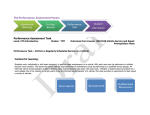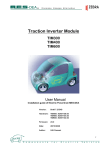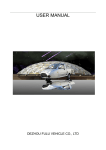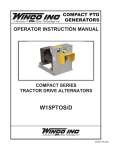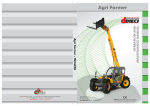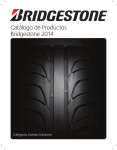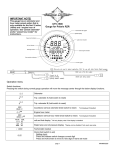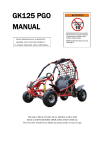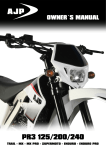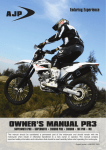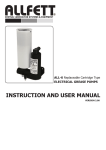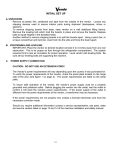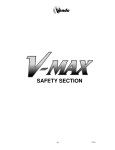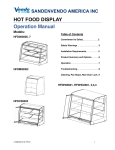Download User manual 20130301_ML.indd
Transcript
User Manual & Maintenance guide Keep this booklet with your vehicle 1 Congratulations on purchasing your e-Tuk! You probably cannot wait to start driving. But, before you get started, read this manual carefully. We have put it together to let you take full advantage of the capabilities of the vehicle. For your safety and the safety of your passengers, please read the instructions carefully. They provide you with helpful information, what to do in case of an error and how to get the most out of your e-Tuk. Also, if you take good care of your vehicle, it will always be in the upmost condition. Keep track of your maintenance in this booklet and follow the maintenance schedule. Thank you and enjoy your driving experience! - The Tuk Tuk Factory team 1 26 Getting familiar 5 Fluids 27 Oil Refill the washer reservoir 27 28 Troubleshooting 29 Jacking Changing tires Vibrating front wheel Towing It’s not working! It’s still not working! BDI error messages 29 29 30 30 31 32 33 Vehicle info 35 Maintenance schedule 37 Your e-Tuk’s DNA 39 Service & maintenance history 40 Battery analysis tools 45 Battery analysis table Drive logging form Battery logging form 45 46 47 Dashboard & handlebars Controls BDI Maximum load Safety 5 7 8 9 10 Driving conditions 11 Temperatures Tips to extend your range 11 12 Battery information 13 Battery health Battery specs Watering the battery 13 15 15 Charging 19 Standard charging sequence The charger display Dashboard charging LED 19 21 22 Electrics 23 The fuse box 12V Battery Tail lights 23 25 25 Driving Changing front light bulbs Battery 3 Maintenance Quick start guide Getting familiar CONTENTS 2 QUICK START GUIDE Direction switch Make sure the vehicle is not being charged, the e-Tuk should not be able to drive while you are charging. Place the charging cable securely under the rear seats. Put the direction switch in neutral N , and make sure the throttle is not engaged. Key LO Unplug CK 3 Turn the key clockwise. The display will switch on and you will hear two *clicks*, one louder than the other. Check the state of charge and if possible the Ub or system voltage. If it is around 76V your battery is full. Parking brake Make sure emergency released. that the button Put in of red is Put the direction switch in D to drive forwards and R to drive backwards. Also make sure the parking brake is released. The early (before 2013) e-Tuk models will not drive when it is engaged. Do not forget to put on your seat belt before you start driving. Getting familiar Display turns on Gently twist the throttle and enjoy your ride! 4 GETTING FAMILIAR Dashboard & handlebars A B 1 2 3 C 30 60 50 20 40 20 10 ON E OFF 5 4 5 6 5 002 0 0 mph 0 0 kmph D A Signal light B Driving lights on/off C Main beam / dip beam D Directions left / right E Horn 10 30 10 40 20 30 20 10 8 70 4 40 80 50 90 100 kmph 50 60 mph 30 2036 60 40 70 50 80 Getting familiar 1 Windscreen washer 2 Windscreen wiper 3 Taxi sign light 4 Windscreen washer fluid 5 Tell-tales display 6 Speedo- & Odometer 7 Battery Display Indicator 8 Charger LED 9 Key switch 10 Throttle 11 Direction Switch 12 Hazard light switch 13 Outlet 12V CK LO 7 8 9 10 11 12 13 *2011 model. Layout may change for newer models 6 GETTING FAMILIAR Controls By pressing the brake pedal with your right foot you will engage the friction brakes. Slowing down and stopping your vehicle can also be done by braking with the motor alone. You can slow down without even using the brake pedal. This will also regain energy and safe kilometres. Turn the throttle to accelerate. By releasing the gas handle the vehicle will automatically use the motor to slow down and stop. The easier you are on the throttle and brakes, the further one single battery charge will take you. Familiarize yourself with the controls on the steer switch before you start driving. Be sure you know where the horn is and use it every 10 seconds if you want to drive Thai-style. Please note that, for safety reasons, the position lights are always on. Don’t worry, they use very little energy and will not affect your vehicle’s range. You’ll notice that the centre headlight cannot be switched on. EU-regulation state that you are not allowed to drive on public roads with three head lights. 7 This is the Battery Display Indicator (BDI). It shows you the battery level and up to date driving information. The number of bars on the display is an estimation of the battery level, not an exact calculation. Getting familiar BDI The display alternates between 4 values: Ub, r, A and H. You can use the display button to select the a parameter if it does not scroll automatically Ub r A h T O The amount of volts drawn from the battery RPM (Rotations Per Minute) of the engine Total number of ampere drawn from the battery Total driving time of the vehicle in hours Temperature of the controller (on some models) Total mileage of the vehicle in km (on some models) The BDI also displays codes in case of an error. To know what these error codes mean, please refer to troubleshoot section on page 33. There is a 12V outlet on the dashboard that is compatible with any 12 Volt car appliance (max 10A). Be careful with any wires that might get entangled in the steering wheel. Please note that the range of your vehicle may be influenced by the type of device that is being used. A phone charger will hardly affect the range, but a heater will be a drain on the battery. There is a 12V outlet in the back of the vehicle too, next to the bench. 8 GETTING FAMILIAR Maximum load Please do not exceed the indicated load capacity of the e-Tuk. Doing so may cause damage to the vehicle and could be dangerous to you and your fellow passengers. Please be aware that your e-Tuk’s driving behaviour and range change when driving around with more passengers or higher loads. e-Tuk Classico MAX 300kg e-Tuk Limo • Driver plus passenger seats for 3 adults • Driver plus passenger seats for 4 adults • or 3 adults & 3 children • or 6 children e-Tuk Cargo e-Tuk Vendo 9 MAX 380 kg • Driver plus 380kg cargo Please note that there is a emergency switch located left from the driver seat. Pressing it will disable the battery and motor and it will make the e-Tuk shut down immediately. Keep in mind that this will not stop the vehicle. You will still have to use the foot brake for that. Getting familiar Safety The Vehicle Identification Number Plate can be found above the brake pedal. This plate contains the e-Tuk’s serial number and other manufacturing information. The serial number is the number that is stamped into the plate. When contacting your service engineer, make sure you have the serial number ready. LO CK Your e-Tuk is equipped with a steering column lock. To engage the lock, turn the handlebars all the way to the right, then turn the key all the way to the left (counter clock wise). Now remove the key and the handlebars are locked into position. Wear your seat belt at all times. You are obligated to wear one, just like in a car. Make sure your passengers wear them too because the ride can get bumpy, especially in the back. And hey, it is the law. If you want to use a child seat in your e-Tuk, first read your child seat manual to see if it can be secured using 3-point seat belt. 10 DRIVING CONDITIONS Temperatures Weather conditions may have affect on performance and vehicle range. High temperatures (35+ °C) combined with high payloads may cause the motor and controller to get very warm. Drive calmly and at a steady pace and give the motor time to cool down every now and again. Cold weather reduces the range of your vehicle, as cold batteries hold less energy. Your vehicle will drive normally but keep in mind that you may get a few kilometres less on a single charge. Tuk Tuk Factory recommends you park your vehicle inside and in a warm environment. The ideal temperature for your battery is 27 °C. Hill inclination Driving uphill draws more energy from the batteries and requires more power from the motor. Keep in mind that while driving in a hilly area, the range of your vehicle will be less than usual. Your vehicle will get you up a hill inclination of 20%. When you are stationary on a hill, do not use the throttle to prevent the vehicle from rolling down the hill. This will cause the controller to get very hot. Instead, use the brake pedal as you would in a normal car. When driving away on a hill, apply throttle and release the foot brake. Your vehicle may roll back slightly before taking off. 11 Tips to extend your range takes you Take a break every once in a while. Your battery pack is just like the human body. You can go further if you rest every now and then. Give further Properly inflated tires reduce road friction. The recommended tire pressure is 3bar / 44psi. Check your e-Tuk’s tire pressure every month. KG Driving the battery some time to recover. More weight means more power from the batteries. For maximum range, leave stuff you do not need at home. Driving to a place with electricity? Charge on the spot! Lower your maximum speed and acceleration, the batteries will last longer if you take it easy on the throttle. By anticipating traffic you can make the ride more comfortable. If you release the throttle you slow down quite rapidly. You regain energy and you do not wear your vehicle’s brakes. 12 BATTERY INFORMATION Battery health Your e-Tuk’s battery is one of the major components of the vehicle. It gives you the energy to get where you need to go. If you can rely on your battery, you can rely on your vehicle. To keep your battery in the best condition you need to take good care of it. Following some basic maintenance rules keeps your battery in good shape. These rules have been set up by the battery manufacturer*. Not following them will void battery warranty. Additional information can be found on the next few pages. Safety • All battery maintenance, except for cleaning and watering, should be done by an authorised service mechanic. Always wear protective clothing, gloves and 13 • • • • goggles when handling batteries Keep flames, sparks or metal objects away from batteries (use insulated tools) Neutralize acid spills with baking soda immediately Charge with vent caps securely in place Provide proper ventilation during charging to prevent explosive gas build up Inspection & Cleaning • Keep batteries clean and dry • Check that all vent caps are tight • Check that all connections are tight (fastening torque is 11 Nm) • Use a solution of baking soda and water to clean if there is acid residue on batteries or corrosion on the terminals • Terminal protectors or protective spray can be applied to reduce corrosion • Batteries should be fully charged prior to and during storage • Never store discharged batteries • Store batteries in a cool, dry place to minimize self-discharge • Recharge batteries prior to putting them back into service to ensure they are fully charged Watering • Add distilled water to cells • Never add acid to cells this is dangerous and will alter the chemistry • Only add water to fully charged batteries. Let the batteries cool down after charging before adding water • If the plates are exposed in discharged batteries, add water to a level just above the lead plates • Add water to the maximum level indicator • Do not overfill the batteries Charging • Batteries should be charged after every use to ensure they are never stored in a discharged condition • If batteries are stored for extended periods of time they should be charged approximately every 6 weeks • Lead-acid batteries DO NOT have a memory affect (they do not need to be fully discharged prior to charging) • The charging cycle should always be finished completely to ensure battery life • If charging cycles have been cut off, equalization should be done. See “Equalization” on page 20. Battery Storage * Source: Trojan batteries 14 BATTERY INFORMATION Battery specs Your e-Tuk has been fitted with 12 Lead-Acid Deep Cycle batteries. Each battery produces 6 Volt and around 185Ah. The total battery pack gives your vehicle 72V to power the motor and electronics. e-Tuks can be fitted with a variety of battery brands. They all work the same and should be serviced in the same manner. However, they cannot be used simultaneously. One broken battery should be replaced with the same type and brand. Watering the battery Your e-Tuk’s battery needs regular watering. The water is an essential part that makes the battery work. During heavy use the batteries heat up and the water evaporates. TTF recommends regular filling (see “Maintenance schedule” on page 37 for more info). Monitoring the amount of water that goes in during filling will give you a good indication of you water use. Experience will teach you if you can extend the filling schedule. Watering can be done per battery cell or, if you have a filling system in one go for the entire pack. ! 15 • Only add water to fully charged batteries, except when battery plates are above the water. • Let the batteries cool down after charging before adding water. Watering the battery manually ! • Never add acid to a battery. • Battery fluid is hazardous! Always protect your clothes, skin and eyes. ! Always use distilled or de-ionized water to refill the battery. Not enough Too Much Battery • Make sure your vehicle is turned off • Make sure that your batteries are fully charged and cooled down • Remove the rubber mat and floor plate in the passenger compartment • Open the vent caps and look inside the fill wells • Check the liquid level; the lead plates in the battery should be submerged. • If necessary, add water until the liquid level is 0.3cm below the bottom of the fill well • A piece of rubber can be used safely as a dip stick to help determine this level • Clean, refit, and tighten all vent caps Just right! 16 BATTERY INFORMATION Refilling the battery using the water filling system If your e-Tuk is fitted with a water filling system. This system lets you fills all batteries at once through a single hose. red flow indicator in the tank’s hose • When the liquid stops flowing the batteries are full Installing a filling system can always be done after delivery. Feel free to contact your distributor for more information. The battery filling system has an indicator for each single battery cell. The indicator shows if the battery is filled and automatically cuts the water feed. • Make sure your vehicle is turned off • Make sure that your batteries are charged and cooled down • Locate the filling hose • Fill your filling tank with de-ionised or distilled water • Connect the hose of your filling tank to the battery hose • Place the filling tank high above the batteries. The e-Tuk’s roof is a good location for this. Gravity will pour the water in the batteries • You will see the water flowing through the 17 Full cell Cell needs filling Advanced watering tools The de-ionising unit can be used directly with battery watering guns. Connect the watering gun to the hose of the de-ionizing unit. Put the nozzle of the watering gun in the battery fill wells and squeeze the trigger. It stops automatically when the battery liquid has reached the correct level. 3P-051-101 3P-051-103 Battery de-ioniser unit Watering gun 3P-051-102 Battery With a de-ionizing unit you can make your own battery water directly from tap water. Feel free to contact your distributor for more information. The de-ionising unit uses special cartridges that can produce up to 2400 litres of battery water. Battery de-ioniser cardridge 18 CHARGING Standard charging sequence Turn off Parking brake Plug in LO CK Remove the key from the key lock. Apply the parking brake to make sure your vehicle does not roll away. Insert the plug into your home socket. The electrical plug that is needed to charge your e-Tuk can be found underneath the rear seats. It is connected to the yellow/black charger box. ! Wait at least 15 minutes before driving off after charging, your batteries need to cool down. Driving immediately after charging will damage your batteries and affects range. ! Always finish the charging sequence. Cutting off a sequence will damage batteries and affects range. If you use an extension cord, make sure it’s fully unwound. Rolled up cords can generate heat. 19 The Delta Q 72V @ 12Amp (5A nominal) is standard equipment on every e-Tuk. You can find it underneath the rear bench. Charging your e-Tuk from 0 to 100% takes about 14 hours. That long? Yes, it takes a while to charge such a huge battery. TTF offers faster chargers, please contact you distributor for more info. Whenever your battery’s performance reduces, or if you were not able to complete a charging sequence, your battery needs to be equalized. Additionally, TTF recommends regular equalization of your battery pack (see “Maintenance schedule” on page 37 for more info). ! Charging your e-Tuk requires high current. Make sure each socket has its own power ‘group’. Only connect ONE QuiQ charger to a single 15A circuit or the circuit may become overloaded. • To equalize your battery, simply charge it until the charger indicates that the battery is full • Pull out the charger plug from the wall socket and put in back in again to start the equalization process • Equalization can take up to 6 hours, depending on the state of your batteries ! Battery Equalization ! Time to charge Is it not charging? • Check for red lights on the charger • Check your outlet/plug connection fuse. 20 CHARGING The charger display The e-Tuk’s standard charger is located underneath the rear bench. It has a display on which you can check the progress of the charging sequence. Cutting off an unfinished charging sequence will lower your battery lifetime. So, waiting for the 100% green light to turn on is the best thing to do. Ampere meter Solid: Displays approximate scale of charge during the first 80%. Flashing: High internal charger temperature. Charging speed is reduced Solid: First 80% charged, the last 20% will go more slowly Flashing: Contact your service supplier Solid: Fully charged Flashing: Charging almost complete, finishing Charger turned on Solid: AC power good Flashing: Low AC Voltage, check voltage and extension cord length Error Flashing: Charger error. Reset charger , contact your service provider 80% ! 21 ! ! ! 100% Dashboard charging LED LO CK Constant: Flashing: Yellow Flashing: Red Flashing: LO Green CK LO CK Fully charged Short: <80% Charge Long: >80% Charge Not constant: Contact your service supplier Reduced Power Mode: Low AC Voltage or High internal charger temperature. Use a shorter extension cord Charging error. Re-plug the charger plug in the socket or contact your service supplier Battery If you do not need detailed charging information, but just want to know if the charging sequence is finished, you can easily check the charging LED on the dashboard. It is located next to the key switch. 22 ELECTRICS The fuse box The e-Tuk several fuses. contains All of the 12V fuses are located in the fuse box underneath the driver seat. To reach the fuse box you will have to remove the driver seat and the cover below it. relay front plug unswitched taxi sign unassigned The illustration shows the location and function of the fuses. unassigned coil supply switched 23 relay unassigned rear plug unassigned radio 5 amp 5 amp When you are replacing fuses, only use blade fuses with amps according to the schedule below. 5 amp 10 amp 5 amp 5 amp 5 amp 5 amp 5 amp unassigned 5 amp 10 amp In order to check if a fuse is broken, carefully remove it from the fuse box. If the metal wire between the 2 poles is broken, the fuse is blown. 5 amp unassigned 5 amp 5 amp unassigned unassigned 5 amp 5 amp 15 amp Ok to use! Maintenance Blown fuse 24 ELECTRICS WARNING 12V Battery The 12V battery can be found underneath the driver’s seat, in front of the fuse box. The battery should give at least 11V. When measuring the voltage, make sure the vehicle is switched off. If the battery voltage is 10V or less, it is time to replace the battery. !NEVER CONNECT THE 12V BATTERY TO THE CHASSIS (B-)! The 12V battery and the 72V battery have common ground. When you connect the ground to the frame, as can be done with regular cars, you will connect the 72V system to the frame. This is very dangerous and should be avoided! Tail lights The tail lights and rear direction indicator lights are highly durable LED light units. If they are not working, please make sure to check the connections and fuses first. If the light is indeed broken, you need to replace the entire unit. 25 Changing front light bulbs If one of your lights is not working, first check if the wiring is properly connected and that the fuse is not broken. To replace the light bulb in the headlights, first remove the entire headlight assembly: • Unscrew the two screws inside the dashboard that holds the headlight in place. • Slide the black rubber protection cap back to reveal the white fitting • Rotate the white fitting to remove it f r o m the metal housing • Do not touch the bulb with your hands, wear gloves or use a handkerchief to unscrew the bulb • Press and turn the light bulb clockwise to remove the bulb from its fitting Use a BA20D 12V 35W bulb. Maintenance 17 mm 54mm 36mm 26 FLUIDS Oil Your e-Tuk uses different types of oil for different parts of the vehicle. Regularly check the ground underneath your vehicle for any traces of fluid that may have leaked. Report any leakage to your local service provider immediately. Differential oil Brake fluid Front fork Check the state of your differential oil every 3 years and replace if necessary. Use about 750ml of 85W90 oil to fill the differential. Check the level of brake fluid every year. Unscrew the body panel that covers the brake pedal. This gives you easy access to the two reservoirs that hold the brake fluid. Check if the level of fluid is between the indicated levels on the reservoirs. Check for any visible leaks. Use DOT 3 or DOT 4 type fluid. Visually check for any leakage. Replace the oil in the front fork when you have spotted leakage or when damping becomes less. Also make sure you replace the forks seals. Use 15W type oil. 27 Refill the washer reservoir Maintenance PUSH LIFT Your windscreen washer can easily be filled with washer fluid. Best way to do it is to lift it out of its holder. This way the opening cap is easy to reach and you won’t spill a drop. 28 TROUBLESHOOTING Jacking To change a rear tire, jack up your vehicle. Remove the screw of the plastic wheel cover. Remove the 4 nuts that hold the wheel in place. Take off the wheel. Make sure you put the new wheel in place and secure the bolts while the vehicle is still jacked up. Jack up the vehicle only underneath the rear suspension spring or rear axle. Only jack up the vehicle on the allocated jacking points. These are the cylindrical blocks underneath the frame. Never jack up the vehicle on the diagonal beam near the rear axle. This will damage the suspension. 29 Changing tires Use a thread locking material on all the bolts before putting the new wheel back in place. We advice using Loctite Blue 242 Nut & Bolt Locker. To change the front tire, jack up the vehicle. Remove the brake calliper and loosen the bolt of the front axle. Remove the front axle to release the front wheel. Pay attention to the right assembly order of the several spacers and other parts. Reassembly is the reverse order of removal. Vibrating front wheel Towing Try to adjust the steering damper if your front wheel is vibrating while driving. The steering damper is located on the right side of the front fork underneath the front fender. In case your vehicle needs to be towed, only use the towing ring at the front of the vehicle. Switch on the vehicle and press the red emergency switch located left of the driver’s seat to disable motor resistance. Make sure your hazard lights are turned on while being towed. If you being towed at night, make sure your tail lights are turned on as well. Maintenance There are multiple damping settings. Rotate the adjuster on the end counter clockwise to switch to a heavier setting. A heavier setting means less ‘wobbling’ and more stability, but also means heavier steering. 30 TROUBLESHOOTING It’s not working! Check the charger cable. Whenever it is plugged in the e-Tuk will not drive. Make sure that the red emergency button is not pressed. Rotate the button clockwise to release. LO CK Do a re-run of the starting sequence. Check if the direction switch is in N Check the battery display for the battery level. Remember that the indication bars are an estimation, not an exact representation of your battery’s charge. 31 Make sure the parking brake is released. The e-Tuk will not drive when it is engaged. Most common errors are shown on page 33. Lights, horn, display, wiper, washer do not work Display does not function Vehicle does not start, no lights, no click X Vehicle starts moving by itself Vehicle rear axle makes a lot of noise Battery does not charge X Motor stops while driving (bump) X Vehicle turns on & clicks but does not drive Vehicle turns on, but no click and does not drive X X X X X Vehicle drives jolty at slow and fast speed X Vehicle does not go up to high speed X Vehicle turns on & clicks but drives only 2 meters X X X X X X X X X X X X X X X X X X X X X X X X X X X X X X X X X X X X X X Maintenance Check the battery display for errors, write them down and communicate them to your service engineer. Er 49 •K e • K y co n e • H y c tac an ont t n • E dl ac ot t f tu m e • C erg (pa aul rne ha en rki ty d c • W rg cy ng) con or b b n re r er • B ong sti utt rak ect ctly o io l a s lc n e n • C tter tar on pu stil n t s on y v -u ec he l on • M tr ol p te d in a oll tag se d • E in c er t e t que nc on oo oo nc • M od tac wa lo e ( o er te r w er • M tor fau r f m ( (<5 ror o co lt aul err 8V 47 ty or ) ) • M tor nn 22 (er o fa ec ro ) • M tor ult tor r2 fa o st 3) ul • T tor alle t y t h e d • D rot mp (er is tle er ro • R pla ca atu r 7 ea y c ble re 3) • R r a on fa to e x ne ul o h • F ar b le d cto t (e igh ro ra iff r f rro • B nt ke ere au r 4 a br s t nt lty 1, 42 • B tter ake ou ial ) at y to chin low f t • B er au uc g o at y f lt: hin / l n o • C ter au m g ock il h y lt: olt / l in • C arg fau low en ock g po in ha er lt: b • 1 rg fau br att les g 2V er lt: oke er n • 3 /r n y o c 5 ela t c hec ce wat pi is on k lls er ns b n m co att ect an nn ery ed ua ec c l to ma orr r f lfu ec au nc tly lty tio n It’s still not working! X X X X X X 32 TROUBLESHOOTING BDI error messages Error What does it mean? 16 Extreme overheating of the controller. Vehicle will not drive. 17 Battery indicates that it is almost empty. Driving speed is reduced. 22 The controller is overheated. Heat sink temperature Drive slowly. Accelerate & Driving speed is reduced. reached +85°C. decelerate little by little. The controller will slowly cool down. 23 Battery power is getting low. Driving speed is reduced. The motor is too hot. Driving speed is reduced. 28 33 What happened? What do I do? Heat sink temperature Prevent aggressive driving. reached +95°C. Allow the controller to cool down. Battery is almost empty. Get to a power outlet and recharge immediately. Battery power is getting low. The motor is overworked. There was too much weight on the vehicle or the hill inclination was too steep. Get to a power outlet and recharge soon. Allow the motor to cool down. Reduce the weight on the vehicle or take a route with less hills. 36 37 38 39 44 47 73 The motor temperature The motor temperature Check the 2 pin connection by sensor is not connected. The sensor is loose. the motor. vehicle will not drive. Encoder error. The encoder is loose. Check the 4 pin connection by the motor. The motor face is open. There was a short circuit in Check the wiring of the motor. Vehicle shuts down. the wiring of the motor. The main contactor is welded The main contactor does Replace the main contactor. shut. Vehicle shuts down. not open anymore. The main contactor did not The main contactor did Check pins on contactors or close. Vehicle shuts down. not close or the tips are replace main contactor. oxidized. There is an error in the The throttle broke or the Check wiring on the throttle, throttle. wiring is faulty. or replace throttle. Vehicle will not drive while You started the vehicle Shut down the vehicle, put direction switch is in D or R. without putting the the direction switch in neural direction switch in neural. (N) and start it again. Stall detected. The motor is Something blocks the mo- Check if something is blockstalled. The vehicle will not tor and prevents it from ing the motor, wheels or drive drive. turning. train. Check the 4 pin connection on the motor. The driving angle is too steep. Maintenance 29 34 VEHICLE INFO Vehicle Driver comfort seat Passenger seats Cargo space (ltr) Maximum payload (kg) Maximum speed (km/h) Range** (km) EU vehicle category Battery Deep cycle Lead-Acid Capacity (kWh) Charging time 0-100% (hrs) Lifetime (years / km) Charger type Delta Q Cargo & Vendo XL ● 3000 300 45 60-70 L5 ● 15 14 14 14 Stretched ● 3 300 45 70-80 L5 ● 15 14 3/100.000 3/100.000 3/100.000 3/100.000 ● ● ● ● ● * ** 35 ● 6 300 45 60-70 L5 ● 15 Cargo & Vendo ● ● 2000 380 45 70-80 L5 ● 15 3+1 Standard Not available Vendo height may differ In a standard e-Tuk city cycle Size and weight ● 7 10 ● 3980 1410 1850 1255 2700 850 Cargo & Vendo XL ● 7 10 ● 3980 1410 1850 1850 1400 1200* 1255 2700 850 155/80R13 155/80R13 155/80R13 155/80R13 145/70R12 145/70R12 145/70R12 145/70R12 Stretched Track (mm) Wheelbase (mm) Kerb weight (kg) Tyre size rear wheels ● 7 10 ● 2980 1410 1850 1255 2270 700 Tyre size front wheel Motor type AC Motor power (kW) Reverse speed (km/h) Controller Curtis 300A Size Cargo space Length (mm) Width (mm) Height (mm) Length (mm) Height (mm) Maintenance Drive train Cargo & Vendo ● 7 10 ● 2980 1410 1850 850 1400 1200* 1255 2270 700 3+1 36 U x x x x x x x x x x x x x x x Flush brake fluid U Clean motor U Equalize batteries Lights check*** U Brake pads and shoes check Tyre profile check U Water batteries* Apply silicone lubricant on rain cover zippers Maintenance done by Weekly or 200km Monthly or every 800km Yearly or every 12.500km Every 2 years or 25.000km Clean steer damper Proper maintenance is key to long vehicle life time. To ensure performance and expected use of the vehicle, stick to this maintenance schedule. Tyre pressure check** MAINTENANCE SCHEDULE U U U M M x x x x x x x x x x x x x x x Storing the vehicle Make sure your vehicle is stored indoors, in a dry environment. Make sure any water left on the vehicle is dried off before storing the vehicle. These are the best conditions for keeping the body and roof cover as good as new. U M 37 You can do this yourself with some basic technical skills This needs to be done by an authorized service and maintenance engineer Grease motor spline Drum brake service Flush differential oil M M M M x x x x x M M M M x x x x x x x x x *The battery manufacturer recommends that batteries be checked once a month. Check the water level of the batteries monthly until you get a feel for how thirsty your batteries are. Also, check all battery pole connections for corrosion. Only fill batteries one hour after charging them. **The optimal tire pressure is 3bar / 44 psi. ***Check to see if all the lights (front, rear, direction indicators) work every week. Maintenance Battery fluid specific gravity measurement x Battery cable replacement x x Battery range check x M Battery terminal service x M Differential oil level and quality check Read controller history M Wiring harness check Replace brake pads M Update controller software Replace brake discs M 38 YOUR E-TUK’S DNA VIN Type Colour Licence plate nr. Installed Options Country Distributor stamp 39 Classico/Limo/Cargo/CargoXL/Vendo/VendoXL SERVICE & MAINTENANCE HISTORY In this section we have reserved space for your service and maintenance provider to keep track of service and repairs on your e-Tuk. Please keep in mind that your vehicle needs regular maintenance. Regular checks need to be done on your battery. You can find the maintenance schedule on page 37. We advice you to keep all invoices you receive for these repairs. They will give additional insight in your vehicle’s history. / / km Date / / Comments Comments Service stamp: Service stamp: Next service km/date Next service km/date km Maintenance Date 40 SERVICE & MAINTENANCE HISTORY Date / km Date / / Comments Comments Service stamp: Service stamp: Next service km/date Next service km/date Date 41 / / / km Date / / Comments Comments Service stamp: Service stamp: Next service km/date Next service km/date km km / / km Date / / Comments Comments Service stamp: Service stamp: Next service km/date Next service km/date Date / / km Date / / Comments Comments Service stamp: Service stamp: Next service km/date Next service km/date km km Maintenance Date 42 SERVICE & MAINTENANCE HISTORY Date / km Date / / Comments Comments Service stamp: Service stamp: Next service km/date Next service km/date Date 43 / / / km Date / / Comments Comments Service stamp: Service stamp: Next service km/date Next service km/date km km / / km Date / / Comments Comments Service stamp: Service stamp: Next service km/date Next service km/date Date / / km Date / / Comments Comments Service stamp: Service stamp: Next service km/date Next service km/date km km Maintenance Date 44 BATTERY ANALYSIS TOOLS Battery analysis table When your battery performance reduces, your service provider could help you to locate the problem. In this section you can find tables that could help you track your battery’s performance. If you copy these blank pages you can use them more then once. To be able to quantify the performance it is adviced to perform a field test, measuring range and voltages. The drive logging form can be used for this. Measuring each battery cell can be done to determine which specific cell underperforms. Each measurement can be filled in the battery logging form. Appropriate values can be found below. 45 % Charge 6 Volt 72 Volt Gravity 100 6.37 76.44 1.277 90 6.31 75.72 1.256 80 6.25 75.00 1.238 70 6.19 74.28 1.217 60 6.12 73.44 1.195 50 6.05 72.60 1.127 40 5.98 71.76 1.148 30 5.91 70.92 1.124 20 5.83 69.96 1.098 10 5.75 69.00 1.073 Drive logging form Time Before drive Voltage Km Time After drive Voltage Km Charging Start time End time 46 BATTERY ANALYSIS TOOLS Battery logging form B01 sg1 B02 sg2 sg3 B04 sg1 sg1 B03 sg2 sg3 B05 sg2 sg3 sg1 sg1 VIN sg2 sg3 Date B06 sg2 sg3 sg1 sg2 sg3 Time B07 sg1 B08 sg2 sg3 B10 sg1 47 sg1 B09 sg2 sg3 B11 sg2 sg3 sg1 sg1 sg2 sg3 sg2 sg3 B12 sg2 sg3 sg1 Total Voltage Notes 48 Notes 49 Maintenance Notes 50 If you are having issues with you vehicle, please contact your local service provider. Before you do, please make sure you have read this manual carefully. If the manual does not give you an answer to your problem, please contact the following: Your local service provider: 51 www.tuktukfactory.com [email protected] 52























































